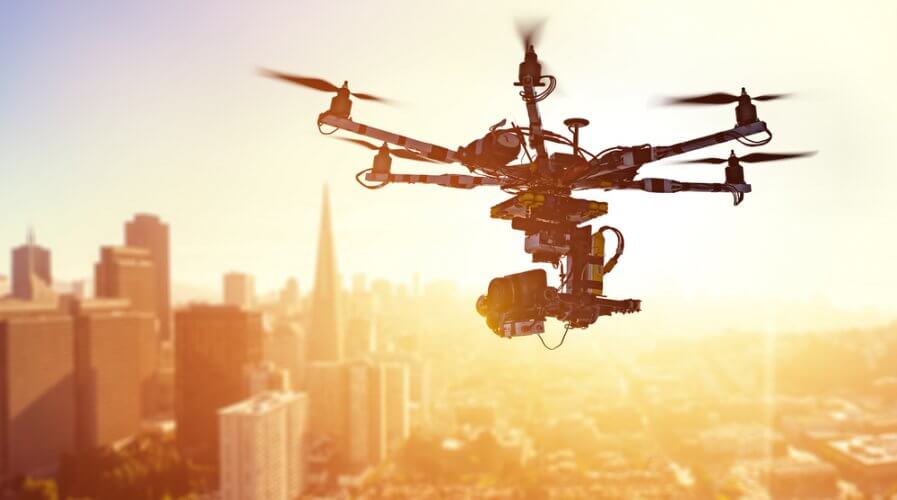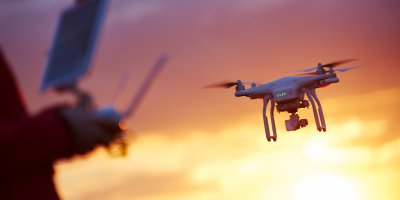
Drone technology is increasingly being used by many industries. Source: Shutterstock
Drone trends to watch out for in 2018
LAST year saw the increase use of drone technology across a wide range of industries. From delivering pizzas to scanning unreachable military bases, today many people are using this technology in weird and wonderful ways, achieving great success in both their operations and marketing initiatives.
The drone is also flying full speed ahead in the consumer market, though some uses of the flying tech have been controversial. For instance, criminals have been using drones to smuggle drugs, and citizens, to spy on their neighbors.
Despite the obvious challenges, the unmanned aerial vehicle (UAV) technology has been shown to have a great impact on the world, even saving the lives of hurricane victims.
And this year, this trend is only set to continue, with an expected total addressable value of US$127 billion by 2020. Set to disrupt various markets including security, infrastructure inspection, and agriculture, The Next Web have outlined four reasons as to why 2018 will be a defining year for the drone industry.
The evolution of drone technology
This year, drones are set to evolve in a variety of ways. Firstly, by an increase in Beyond Visual Line-of-Sight (BVLOS) missions. Currently, users must be able to see the drone they’re using in sight. But with the development of BVLOS, the flyer can be in one location, while the drone is carrying out its job in another. This will especially impact security and surveillance systems.
Today, drones tend to work by collecting data and then bringing it back to the operator who will then analyze the footage. This year, drones are set to reach a new level of automation and data analysis capability. Through computer vision and neural network technologies, drones will have the potential to capture and generate more data in real time, diminishing the need for human direction.
Mass adoption by security and emergency response
Last year, drones have provided an incredible example of how significant an impact they can have on many industries, specifically law enforcement, security, and first response.

Source: Shutterstock
For instance, drones were used to deliver emergency relief supplies to Texas, Florida and Puerto Rico.
Furthermore, in the aftermath of Hurricane Irma, the Florida Air National Guard enlisted the help of combat drones to perform aerial surveys of the disaster area, allowing them to assess where to focus their efforts.
With commercial drones becoming increasingly more advanced – with longer flight times, heavier payloads and more secure systems – they can be used more effectively by security and emergency response professionals.
Increased regulation
Though often associated with limiting growth, the regulation of drones will lead to more professional use of the technology and address concerns over privacy, safety, and national security.
Criminals are increasingly using commercially-available drones to carry contraband. In 2015, two people were caught dropping off 28 pounds of heroin in California. With drones being easy to fly and difficult to spot, they are an attractive mode of transport for many criminals.
But with these criminals becoming more tech savvy, it is clear that law enforcement must keep a vigilant eye out.
In the UK, the government has already introduced regulations to crackdown on dangerous flying and criminal drone use. As drones become more integrated into the market, it is clear these regulations will get tighter.
Drones-as-a-Service (DaaS)
You are likely to have heard of Software-as-a-Service, but 2018 is set to see the introduction of DaaS: Drones-as-a-Service.
Drone technology has a variety of uses for companies across many different industries, with the ability to gather data in a fraction of the time these jobs used to take when carried out by humans.
Yet, the problem for businesses looking to harness the potential of drones is the complex and expensive process of maintaining them, the obstacles to finding well-trained pilots, and making sense of the data that is gahered.
DaaS companies such as Measure, seek to help companies exploring how best to use drones to solve typical business problems.
“Typically, a customer will reach out with a use case. For example, inspecting a wind farm,” Measure CEO Torres Declet told Business News Daily.
“We work with them to figure out exactly what type of data, pictures, and video they need. We select the right drone and sensor for them. We acquire it if we don’t already have it in our fleet.”
The company then select a pilot from its staff to operate the drone and gather the requested data. This data is then passed on to Measure’s data engineering team who analyzes it and present the findings to the client.
It is clear that DaaS will only get bigger this year, developing new cases for drone technology in the business world.








